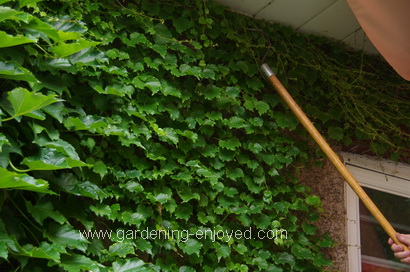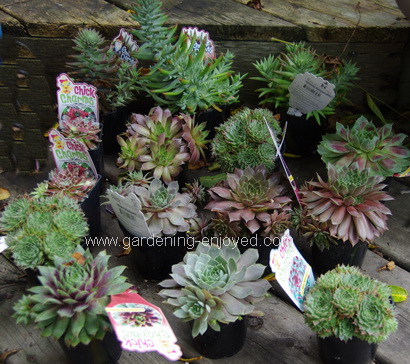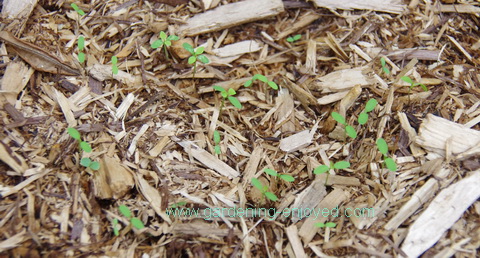| Back to Back Issues Page |
 |
|
Dallying In The Dirt, Issue #300 - The cursed weeds defy the best laid mulch. August 20, 2017 |
 We use the expression “grows like a weed” for a few valid reasons. It certainly fits the Boston Ivy on the side of my house. Now, I really like that Ivy. It shades the house in the summer. It adds greatly to the cottage look of the place and it has great fall colour. Its one downfall is that it “grows like a weed.” Each year there is the great pruning. This year I found a new use for one of my favourite tools the Cobra Head. It is a disarmingly simple looking tool that now comes in three sizes and does some amazing work. Getting the Boston Ivy off the walls of my house is probably not listed as a use on their website but their long handled version did a great job. The short handled version has been used constantly for the past weeks to help excavate and separate the Iris and Daylilies that are leaving the
garden. This year they have a new mini version and it was great for extricating all of the soil from the roots of those departing plants. All sizes have several more prosaic uses that make them indispensable in my garden. They remove weeds but not without some effort on my part and not as fast as the weeds seem to grow. Maybe next year they will have a motorized version.☺
We use the expression “grows like a weed” for a few valid reasons. It certainly fits the Boston Ivy on the side of my house. Now, I really like that Ivy. It shades the house in the summer. It adds greatly to the cottage look of the place and it has great fall colour. Its one downfall is that it “grows like a weed.” Each year there is the great pruning. This year I found a new use for one of my favourite tools the Cobra Head. It is a disarmingly simple looking tool that now comes in three sizes and does some amazing work. Getting the Boston Ivy off the walls of my house is probably not listed as a use on their website but their long handled version did a great job. The short handled version has been used constantly for the past weeks to help excavate and separate the Iris and Daylilies that are leaving the
garden. This year they have a new mini version and it was great for extricating all of the soil from the roots of those departing plants. All sizes have several more prosaic uses that make them indispensable in my garden. They remove weeds but not without some effort on my part and not as fast as the weeds seem to grow. Maybe next year they will have a motorized version.☺ I meet the Cobra Head people every year at our Garden Writer’s meeting and trade show. That is also where we get to see the newest plants and the newest trends in plants. Succulents, both indoors and out are the latest and greatest things to be planting. These Sempervivums, (Hens & Chicks) are the result of some fancy plant breeding and selecting from the several hundred species of these tough succulents. This work has created the latest plant collectibles from a rather staid old standard of the rock Garden. Marketed in the USA as Chick Charms these vary hardy and tough plants can now be found in several colours and shapes. This is the group that I brought home from that trade show and they will soon be gracing the new scree garden at the front of the yard and some of the rockery around the waterfall. I know, I’m supposed to be downsizing but these cute little fellows take care of themselves and the scree garden does not support many weeds. Gardening, it’s an
addiction.
I meet the Cobra Head people every year at our Garden Writer’s meeting and trade show. That is also where we get to see the newest plants and the newest trends in plants. Succulents, both indoors and out are the latest and greatest things to be planting. These Sempervivums, (Hens & Chicks) are the result of some fancy plant breeding and selecting from the several hundred species of these tough succulents. This work has created the latest plant collectibles from a rather staid old standard of the rock Garden. Marketed in the USA as Chick Charms these vary hardy and tough plants can now be found in several colours and shapes. This is the group that I brought home from that trade show and they will soon be gracing the new scree garden at the front of the yard and some of the rockery around the waterfall. I know, I’m supposed to be downsizing but these cute little fellows take care of themselves and the scree garden does not support many weeds. Gardening, it’s an
addiction. The great plant sale continues. It will be operating again this Saturday, Aug. 26, at our garden at 111 Trent St. W. Whitby ON. These Japanese Anemones or Windflowers should be in pots and ready for sale. There is still a good selection of Iris and Daylilies as I continue to dig up more clumps every day. I do like these Anemones at this time of year but they do want to slowly take over the garden so they need to be given a spot where they can be controlled or else have enough space to stretch their legs. My clump will be greatly reduced probably to make room for some of the Iris that I just cannot part with. All of this is happening in the front garden beds which are being revitalized and updated and, just possibly, made a bit larger. How much time, effort and money do I put into mulching these beds when I have finished replanting them. See paragraph #1. One of them has a very pernicious weed that I know as perennial Sow Thistle. Sonchus
arvensis has a deep spreading underground root system that make it very difficult to remove by pulling. Some very deep digging will get most of it but that one small bit of root that you missed will eventually sprout. No amount of mulch will keep it down and non-chemical control is almost impossible. That is one of the reasons that these beds are being so extensively reworked. Weeds *%&*^$#&*^!!!
The great plant sale continues. It will be operating again this Saturday, Aug. 26, at our garden at 111 Trent St. W. Whitby ON. These Japanese Anemones or Windflowers should be in pots and ready for sale. There is still a good selection of Iris and Daylilies as I continue to dig up more clumps every day. I do like these Anemones at this time of year but they do want to slowly take over the garden so they need to be given a spot where they can be controlled or else have enough space to stretch their legs. My clump will be greatly reduced probably to make room for some of the Iris that I just cannot part with. All of this is happening in the front garden beds which are being revitalized and updated and, just possibly, made a bit larger. How much time, effort and money do I put into mulching these beds when I have finished replanting them. See paragraph #1. One of them has a very pernicious weed that I know as perennial Sow Thistle. Sonchus
arvensis has a deep spreading underground root system that make it very difficult to remove by pulling. Some very deep digging will get most of it but that one small bit of root that you missed will eventually sprout. No amount of mulch will keep it down and non-chemical control is almost impossible. That is one of the reasons that these beds are being so extensively reworked. Weeds *%&*^$#&*^!!!Now it’s time to answer a few of my reader’s questions. To ask a question just “reply” to this ezine. Don’t forget to check the front page of the Website for frequent short ideas for current gardening activities. Linda Asks? I was wondering is there any such thing as putting too much compost around your plants? Thanks, Keep those news letters coming. Dan Asks? My tomato plants have developed what appears to be a fungus. The leaves are turning brown covering the complete plant and then falling off. The fungus is moving from one plant to another. It is not attacking the tomatoes. I obviously don't want to treat the plants not knowing what it is or applying anything that will be harmful to ingest. |
| Back to Back Issues Page |
